Watches & Wonders: Thoughts On The 20th Anniversary Of The Hublot Big Bang, And The 20th Anniversary Collection
Sometimes controversial, but worn and loved by many, the Big Bang has become an essential feature of the modern watchmaking landscape.
The Big Bang, like the cosmological event after which it was named, is unique and it has also produced a whole plethora of outcomes since the first models were launched all the way back in 2005 (which seems even further long ago than it is).
The appearance of the Big Bang is tied intimately to the birth and evolution of Hublot itself, which was founded by the Italian entrepreneur Carlo Crocco in 1980. Crocco had worked at the Binda Group, an Italian luxury brand, but wanted to have his own company, which at first wasn’t called Hublot, but rather, the MDM Group, and Hublot was the name of a model whose design influence is still very much a part of Hublot, and the Big Bang, today. The name “Hublot” means “porthole” and while, of course, both the Patek Nautilus and Audemars Piguet Royal Oak are said to have had similar design influences (the Nautilus from a porthole and the Royal Oak, allegedly, from the viewport frame of a diver’s helmet) the Hublot watch managed to establish its own identity. This was partly due to the design, which while debatably showing the influence of the Royal Oak, was different enough to stand on its own, and as well, for the use of a rubber strap on a luxury watch, in contrast to its predecessors for which an integrated metal bracelet was essential.
That combination of unexpected materials was what led in due course, to the creation of the Big Bang, which debuted in 2005. By then, Jean-Claude Biver had been CEO for a year, and with the introduction of the Big Bang, sales exploded. In March of this year, Robin Swithinbank, writing for the New York Times, interviewed Biver:
“But its sales [of the Big Bang] significantly changed the brand’s finances. According to Mr. Biver, the company’s 2004 revenues totaled 28 million Swiss francs. By 2008, he continued, the figure was ‘more than 200 million,’ and the brand was acquired by LVMH Moët Hennessy Louis Vuitton, the luxury giant that owns the TAG Heuer and Zenith watch companies. Mr. Biver said the deal was worth ‘close to 450 million Swiss francs.'”
The Birth Of Big Bang
The name, Big Bang, was coined by Jean-Claude Biver during one of his earliest conversations with Carlo Crocco. In an interview with Europastar in 2019, Biver recounted his initial meeting:
“During our interview I asked him: ‘What is your message with your brand?’ Carlo Crocco replied: ‘We’ve made a gold watch and for the first time we’ve mounted it on a rubber strap. Its design, that resembles a porthole, is reminiscent of the yachting world, the sea….’
I said to him: ‘But what you’re telling me there is the product description, that’s not a message!’ And I made a drawing for him that any child could understand.
I explained to him that the most important thing was the concept. I drew the sky, and there’s the Earth. On this Earth there are trees, underground there are treasures, oil, uranium, gold. But gold and rubber have never been associated, because gold is underground and rubber in the trees. But they were together once upon a time, before the Big Bang, and when the Big Bang happened, the gold said “I’m going underground” and the rubber said “I’m off to the trees”.
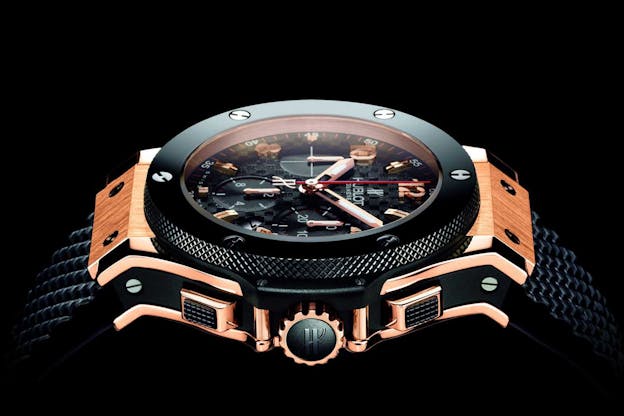
And since the Big Bang they’ve never been together, but you, Mr Crocco, you have brought the gold back from underground, and you’ve brought the rubber down from the tree and you’ve fused them together. And you’ve created the first fusion in the art of watchmaking. And so I’m going to call the brand’s message the ‘Art of Fusion’ and I’m going to call the watch Big Bang.”
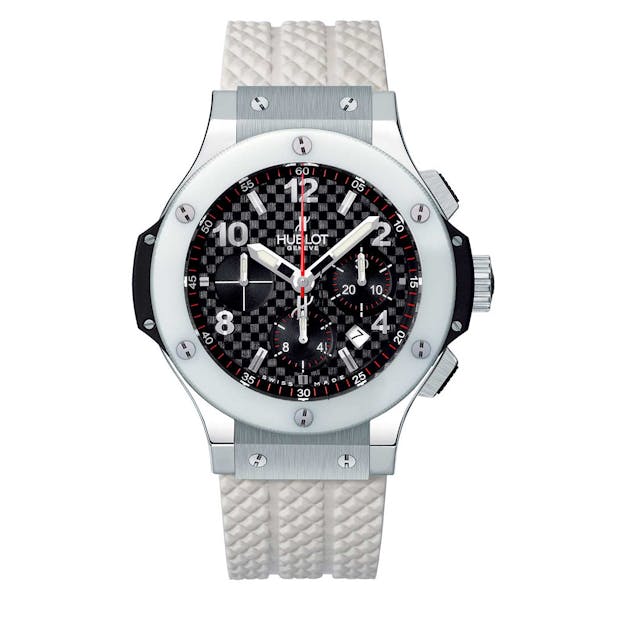
The Big Bang won big the first year that it was out, at the Grand Prix de Horlogerie de Genève (GPHG) where it took the Design Watch Prize. The basic design elements used in the prize-winning watch are still there today, including the use of ceramic for the knurled bezel; the mixture of ceramic with a different case metal (steel, in the case of the GPHG model) a rubber strap; Kevlar case inserts, and the six visible screws fixing the bezel in place.
Big Bang Chronograph Calibers
The Big Bang chronographs have had several different movements over the years, including a modified Valjoux/ETA 7750, as the HUB 4100, and in some cases, an ETA 2894-2 base with chronograph module. However, in 2010, Hublot introduced the in-house Unico flyback chronograph movement in the Big Bang Unico.
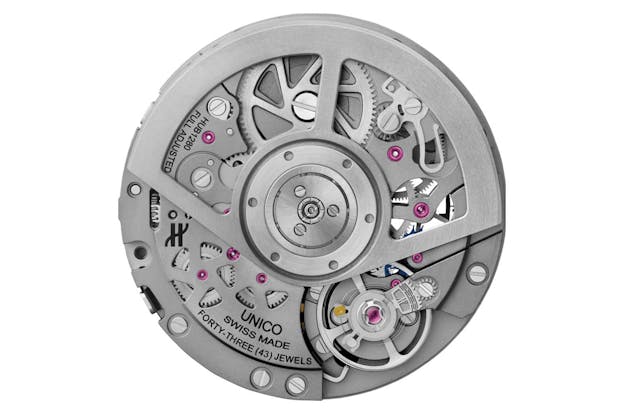
The first version, caliber HUB 1240, had dimensions similar to the 7750 and therefore could be used as a drop-in replacement in existing designs, although its architecture was different in order to give a more kinetic visual experience; Jean-Claude Biver, in a 2018 story on the development of the Unico caliber at PuristsPro.com, said, “We just wanted to keep the incredible quality of the 7750, but have it modernized with a column wheel, a double clutch, chronograph functions on the side of the dial and a flyback. But basically we should keep some of the construction rules of the 7750 and fuse them with modernity.
Unico is a fusion between 7750 and the future.” HUB 1240 was 30mm x 8.05mm and had its chronograph and coupling system on the dial side, as well as a silicon lever and escape wheel; in 2018, the HUB 1280/Unico 2 was introduced, which is significantly thinner at 30mm x 6.75mm and therefore, can be used in thinner cases. Unico 2 had some new features five of which were granted patents. The major difference in terms of dial layout between the 7750 Big Bang models, and the Unico/Unico 2 models, is that the latter don’t have a small seconds display at 6:00, which is perhaps the most notable first-glance difference between the original Big Bangs, and the five new models in the 20th Anniversary Collection.
The 7753-based HUB 4100 is still in use in the Big Bang Original Collection, while the Unico 2 calibers are used in the Big Bang Unico Collection.
The 20th Anniversary Collection
Although a number of watches were released by Hublot for the 20th anniversary of Big Bang, there are five specific watches in the 20th Anniversary Collection, which, as Hublot says, combines features of both the original design, and the Big Bang Unico watches.

Stylistically, the 20th anniversary models more closely resemble the original Big Bang models than they do the current Unico watches, although there are of course elements of both in the 20th Anniversary watches. The current Unico Big Bang watches and the Original Collection pieces have, of course, a family resemblance but there are immediately noticeable differences as well.
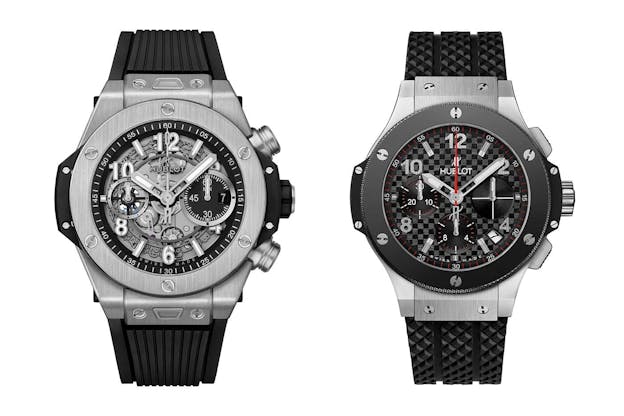
The Big Bang Unico chronographs are 44mm or 42mm in diameter, with the Original models coming in at 44mm or 41mm. Noticeable differences include the quick-change system for the straps on the Unico model, which also has larger, more rounded chronograph pushers. The biggest difference, though is in the dial, with the Unico chrono having an open dial that shows off the chronograph switching system, while the Original model has the closed dial and carbon fiber-style embossing found in the Big Bang launch models from 2005.
The new 20th Anniversary models are being produced in King Gold, Magic Gold, Red Ceramic, All-Black Ceramic, and Titanium. Magic Gold and King Gold are two of Hublot’s proprietary god alloys; Magic Gold has been described by Hublot as “virtually scratchproof” and it’s a sintered combination of boron nitride (an industrial ceramic) and pure gold, with a high enough gold percentage to make it an 18 karat gold alloy. King Gold was developed by Hublot in order to have a more reddish red gold than conventional alloys; like some other proprietary red or rose gold alloys, the reddish color is thanks to the addition of copper, with some platinum added to prevent the copper from oxidizing.
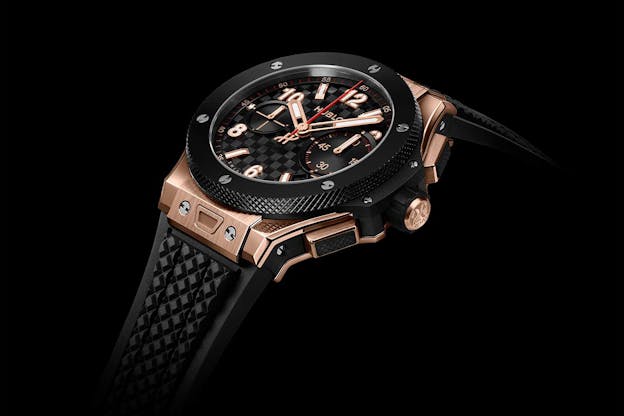


Dimensions for all models are 43mm x 13.20mm, and all models use the Unico 2 caliber HUB 1280, with flyback function.



The 20th Anniversary models are a combination of the technical features Hublot has introduced since 2005, including the use of colored ceramic, King Gold and Magic Gold alloys, the One Click strap changing system, and of course, the Unico 2/HUB 1280 caliber, with its silicon escapement and 72 hour power reserve. The knurled bezel, rectangular chronograph pushers, and especially, the closed dial with its carbon fiber-weave pattern, are all features found in the original Big Bang. Probably the biggest departure from the originals design-wise is that the 20th Anniversary pieces don’t have a seconds subdial at 6:00, since that’s not supported by the Unico caliber.
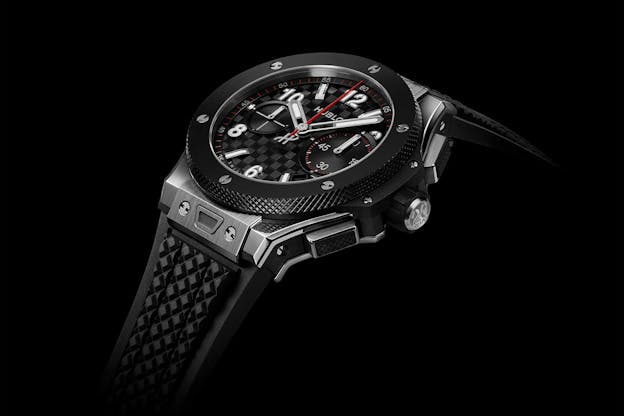
These are quite well thought combinations of old and new – the size keeps them in the impactful range so many of us associate with the Big Bang, and the closed dial, rectangular pushers, and combination of classic design features with modern technology and materials, makes these a very satisfying look back at the history of one of modern watchmaking’s most important and influential designs, as well as a bit of a look forward as well.

The controversy among collectors that has surrounded the Big Bang in particular, and watchmaking at Hublot in general, since the launch of the Big Bang in 2005, is partly thanks to the brash and sometimes frankly in-your-face marketing of the watches (and the extremely brash and in-your-face personality of Jean-Claude Biver, one of the most bluntly outspoke and mercurial individuals I’ve ever worked with in the industry, which are qualities which as a journalist, I miss). But in recent years, there has been I think, something of a reappraisal in enthusiast circles of the Big Bang. It’s always been enormously commercially successful but the design was born at a time when there was a lot of “the question isn’t why, it’s WHY NOT” going on in watch design, and not all of the designs of that era have aged well. However, the Big Bang has persisted and after two decades, I think now more than ever its extroverted character is a breath of fresh air, especially when there’s so much backwards-looking sentiment and backwards-looking design going on in the watch world. Rock and roll was once revolutionary but now classic rock’s a recognized and beloved genre and has been for decades, and so it is with the Big Bang – a blast from the past that’s once again finding its place in the sun in the present.
The 20th Anniversary Big Bang Collection: cases, 43mm x 13.20mm, water resistance 100M; King Gold, Magic Gold, All Red Ceramic, All Black Ceramic, and Titanium. Movements in all models, Unico 2/HUB 1280, automatic flyback chronograph with column wheel and date; silicon lever escapement, running at 28,800 vph in 43 jewels. All models with matching “structured rubber” straps and One Click strap changing system.
Reference numbers, limited editions, and pricing: Titanium, 431.NM.1337.RX, 500 pieces, $20,800; Red Ceramic, 431.CF.1313.RX, 100 pieces, $31,800; Magic Gold, 431.MX.1330.RX, 100 pieces, $40,500; King Gold, 431.OM.1338.RX, 250 pieces, $38,400; All Black Ceramic, 431.CI.1340.RX, 500 pieces, $25,200.
The 1916 Company is proud to be an authorized retailer for Hublot. Please contact us for availability, or reach out to our Hublot Boutique.

